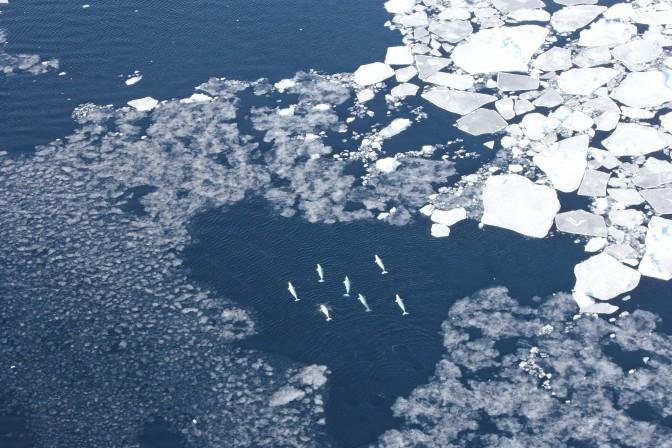A pod of beluga whales is seen swimming near West Greenland sea ice. Photo by Kristin Laidre/University of Washington
SEATTLE, Feb. 12 (UPI) -- Beluga whales live in faraway arctic waters that are deathly cold and difficult to navigate. The conditions make gathering comprehensive data on the species quite difficult.
But new and improved tagging technology is helping scientists learn more about the whales' foraging and migration patterns.
A team of biologists from the University of Washington recently analyzed and organized tracking data from 30 whales, recorded over the course of the last 15 years. They published their work this week in the journal Marine Ecology Progress Series.
"This study gives us a benchmark of the distribution and foraging patterns for these two beluga populations," lead study author Donna Hauser, a doctoral student in Washington's School of Aquatic and Fishery Sciences, said in a news release. "However, there still needs to be additional work to see how beluga behavior has changed in concert with changing sea ice conditions in the arctic."
There are two distinct populations of beluga whales, but both spend the winters in the Bering Sea. When arctic sea ice melts in the summer, the whales move north and spread out into the Beaufort and Chukchi seas.
As the new tagging data confirms, the whales' interest in these pockets of arctic water is explained by the presence of arctic cod. Dive data shows the belugas frequent depths between 650 and 1,000 feet, where arctic cod congregate. But the numbers showed belugas also visit the ocean bed in search of prey, and their preferred depths vary significantly based on the topography of the sea floor.
Establishing a baseline for normal foraging patterning among the two beluga populations is vital to scientists who are monitoring the effects of global warming on vulnerable marine mammals. The data also has implications for wildlife officials and fisheries managers.
"The results of this work can be used not only to understand ecological relationships for arctic top predators, but also inform the management of beluga whales, which are an important subsistence resource for northern communities," explained study co-author Kristin Laidre, an assistant professor of aquatic and fishery sciences at Washington.
Climate change is happening most dramatically in the arctic, and biologists need accurate data to understand how marine life there is changing. Researchers are especially interested to find out whether the belugas will delay their autumnal return to the Bering Sea as the arctic stays unfrozen later into the year.















